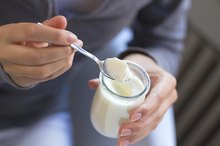What does fact checked mean?
At Healthfully, we strive to deliver objective content that is accurate and up-to-date. Our team periodically reviews articles in order to ensure content quality. The sources cited below consist of evidence from peer-reviewed journals, prominent medical organizations, academic associations, and government data.
The information contained on this site is for informational purposes only, and should not be used as a substitute for the advice of a professional health care provider. Please check with the appropriate physician regarding health questions and concerns. Although we strive to deliver accurate and up-to-date information, no guarantee to that effect is made.
Diet for Bacterial Vaginosis
Bacterial vaginosis describes a type of vaginitis that produces a redness or swelling of the vagina often accompanied by discomfort, vaginal discharge and itching. A healthy vagina contains several different types of bacteria. Bacterial vaginosis, or BV, results when normally occurring bacteria proliferate. BV may cause a fishy smell, especially after sex. Antibiotics are typically prescribed for BV, but dietary changes may also be necessary in order to prevent it from becoming a chronic condition.
If you are experiencing serious medical symptoms, seek emergency treatment immediately.
Lactobacillus Acidophilus
Bacterial vaginosis stems from an imbalance in the vaginal ecosystem 3. Eating foods that contain lactobacilli may bring the vaginal ecosystem back to a healthy and balanced state. In “The Health Professional’s Guide to Popular Dietary Supplements,” authors Shawn M. Talbott and Kerry Hughes note that lactobacillus acidophilus, or LA, is a healthy bacteria; the consumption of foods with LA has been linked to lower rates of BV. Yogurt, kefir and acidophilus milk are all potential sources of LA.
- Bacterial vaginosis stems from an imbalance in the vaginal ecosystem 3.
- Eating foods that contain lactobacilli may bring the vaginal ecosystem back to a healthy and balanced state.
Garlic
Can Avoiding Certain Foods Prevent Bacterial Vaginosis?
Learn More
Garlic contains natural antibiotic properties and for this reason is recommended to anyone who is prone to bacterial vaginosis. Jean Carper, author of “Food Your Miracle Medicine: Preventing and Curing Common Health Problems the Natural Way” maintains that garlic is effective on a wide range of bacteria. Garlic is recommended as a vaginal suppository and is also effective when eaten.
Foods to Avoid
In “The Gynecological Sourcebook,” M. Sara Rosenthal, Ph.D., explains that diet can play an important role in the management of bacterial vaginosis 4. Rosenthal emphasizes avoiding sugar. The authors of “Our Bodies, Ourselves” say consuming sugar can lead to a vaginal environment that encourages the growth of bacteria. It is also advisable to avoid caffeine, alcohol, foods that include:
- mold
- fermented foods
- processed foods
- those high in carbohydrate
- In “The Gynecological Sourcebook,” M. Sara Rosenthal, Ph.D., explains that diet can play an important role in the management of bacterial vaginosis 4.
- The authors of “Our Bodies, Ourselves” say consuming sugar can lead to a vaginal environment that encourages the growth of bacteria.
Foods to Favor
Recurrent Yeast Infections and Eating Too Much Sugar
Learn More
A healthy diet leads to a stronger immune system and decreases the likelihood of contracting bacterial vaginosis.
Herbs
Echinacea can be made into a tea or a tincture. Bacterial-Vaginosis.com and Balch also recommend pau d’arco, which may also be made into a tea.
Related Articles
References
- “The American Medical Association Complete Guide to Prevention and Wellness: What You Need to Know about Preventing Illness, Staying Healthy, and Living Longer”; 2008; American Medical Association
- “Sexually Transmitted Diseases Sourcebook”; Laura Larsen, editor; 2009
- National Institute of Allergy and Infectious Diseases: Bacterial Vaginosis
- “The Gynecological Sourcebook”; M. Sara Rosenthal, Ph.D.; 2003
- “S.E.X.: The All-You-Need-to-Know Progressive Sexuality Guide to Get You Through High School and College”; Heather Corinna; 2007
- “Guide to Getting it On” ; Paul Joannides; 2009
- Reiter S, Kellogg spadt S. Bacterial vaginosis: a primer for clinicians. Postgrad Med. 2019;131(1):8-18.
- Bilardi J, Walker S, McNair R, et al. Women's Management of Recurrent Bacterial Vaginosis and Experiences of Clinical Care: A Qualitative Study. PLoS One. 2016;11(3):e0151794. Published 2016 Mar 24. doi:10.1371/journal.pone.0151794
- Koumans EH, Sternberg M, Bruce C, et al. The prevalence of bacterial vaginosis in the United States, 2001-2004; associations with symptoms, sexual behaviors, and reproductive health. Sex Transm Dis. 2007;34(11):864-9.
- Kumar N, Behera B, Sagiri SS, Pal K, Ray SS, Roy S. Bacterial vaginosis: Etiology and modalities of treatment-A brief note. J Pharm Bioallied Sci. 2011;3(4):496–503. doi:10.4103/0975-7406.90102
- McDonald HM, Brocklehurst P, Gordon A. Antibiotics for treating bacterial vaginosis in pregnancy. Cochrane Database Syst Rev. 2007;(1):CD000262. Published 2007 Jan 24. doi:10.1002/14651858.CD000262.pub3
- Kairys N, Garg M. Bacterial Vaginosis. [Updated 2019 May 4]. In: StatPearls [Internet]. Treasure Island (FL): StatPearls Publishing; 2019 Jan-. Available from: https://www.ncbi.nlm.nih.gov/books/NBK459216/
- Kumar N, Behera B, Sagiri SS, Pal K, Ray SS, Roy S. Bacterial vaginosis: Etiology and modalities of treatment-A brief note. J Pharm Bioallied Sci. 2011;3(4):496–503. doi:10.4103/0975-7406.90102
- Muzny CA, Schwebke JR. Pathogenesis of Bacterial Vaginosis: Discussion of Current Hypotheses. J Infect Dis. 2016;214 Suppl 1(Suppl 1):S1–S5. doi:10.1093/infdis/jiw121
- Mackelprang RD, Scoville CW, Cohen CR, et al. Toll-like receptor gene variants and bacterial vaginosis among HIV-1 infected and uninfected African women. Genes Immun. 2015;16(5):362–365. doi:10.1038/gene.2015.13
- Money D. The laboratory diagnosis of bacterial vaginosis. Can J Infect Dis Med Microbiol. 2005;16(2):77–79. doi:10.1155/2005/230319
- Cook RL, Reid G, Pond DG, Schmitt CA, Sobel JD. Clue cells in bacterial vaginosis: immunofluorescent identification of the adherent gram-negative bacteria as Gardnerella vaginalis. J Infect Dis. 1989;160(3):490-6.
- Bradshaw CS, Sobel JD. Current Treatment of Bacterial Vaginosis-Limitations and Need for Innovation. J Infect Dis. 2016;214 Suppl 1(Suppl 1):S14–S20. doi:10.1093/infdis/jiw159
- Menard JP. Antibacterial treatment of bacterial vaginosis: current and emerging therapies. Int J Womens Health. 2011;3:295–305. doi:10.2147/IJWH.S23814
- Homayouni A, Bastani P, Ziyadi S, et al. Effects of probiotics on the recurrence of bacterial vaginosis: a review. J Low Genit Tract Dis. 2014;18(1):79-86.
- Muzny CA, Schwebke JR. Pathogenesis of Bacterial Vaginosis: Discussion of Current Hypotheses. J Infect Dis. 2016;214 Suppl 1(Suppl 1):S1–S5. doi:10.1093/infdis/jiw121
- Allworth, J. and Peipert, J. Severity of Bacterial Vaginosis and the Risk of Sexually Transmitted Infection.Am J Obstet Gynecol. 2011; 205(2):113.e1-113.e6. doi:10.1016/j.ajog.2011.02.060.
- Bagnall, P. and Rizzolo, D. Bacterial vaginosis: A practical review.J Am Acad Phys Assist. 2017; 30(12):15-21. doi:10.1097/01.JAA.0000526770.60197.fa.
- CDC. Bacterial Vaginosis (BV) Statistics: Bacterial vaginosis is the most common vaginal infection in women ages 15-44. Updated December 17, 2015.
- Centers for Disease Control and Prevention. 2015 Sexually Transmitted Diseases Treatment Guidelines: Bacterial Vaginosis. Atlanta, Georgia; updated June 4, 2015.
- Hainer, B. and Gibson, M. Vaginitis: Diagnosis and Treatment. Am Fam Physician. 2011; 83(7):807-815.
Writer Bio
Judith Eldredge is a board-certified sexologist with a master's degree in human sexuality from the Institute for Advanced Study of Human Sexuality. She has been teaching people about sex and helping them realize their erotic potential since 2003.








